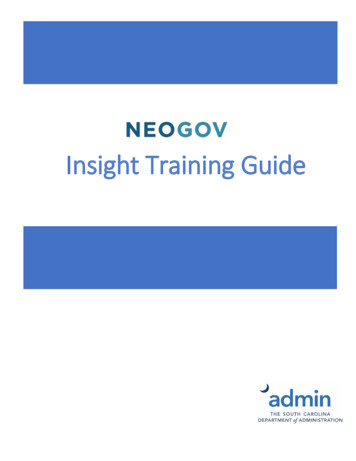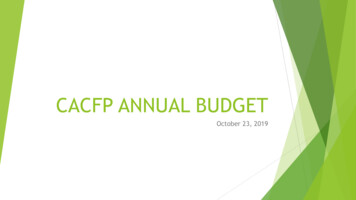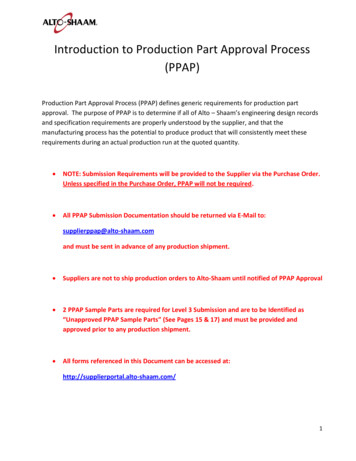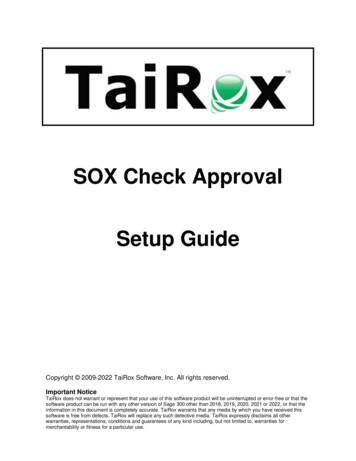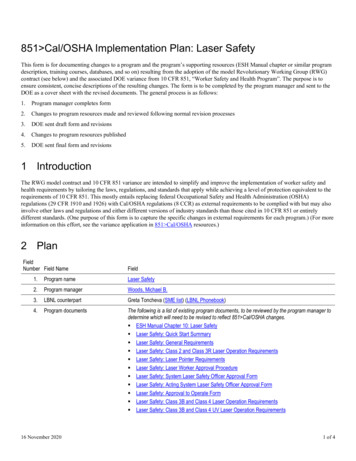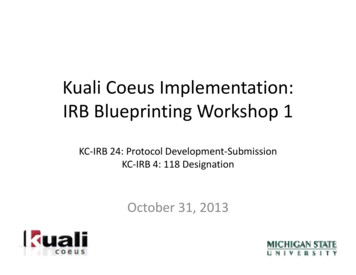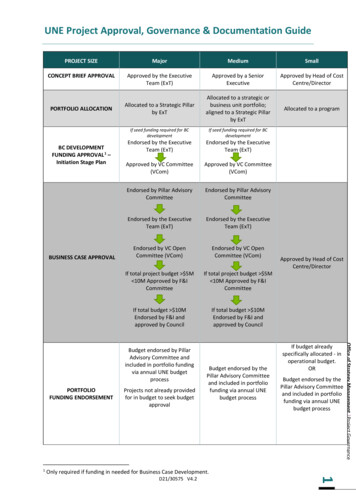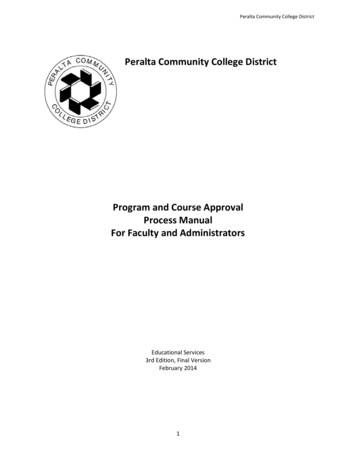
Transcription
Peralta Community College DistrictPeralta Community College DistrictProgram and Course ApprovalProcess ManualFor Faculty and AdministratorsEducational Services3rd Edition, Final VersionFebruary 20141
Peralta Community College DistrictPeralta Community College DistrictBoard of TrusteesAbel Guillén, Board PresidentMeredith Brown, Board Vice PresidentCy GulassaLinda HandyDr. William “Bill” RileyBill WithrowDr. Nicky González YuenStudent Trustees:Sharon CleggWai LiDr. José M. Ortiz, ChancellorPresidentsDr. Deborah Budd, Berkeley City CollegeDr. Eric V. Gravenberg, College of AlamedaDr. Elñora Tena Webb, Laney CollegeDr. Norma Ambriz-Galaviz , Merritt CollegeDistrict AdministrationEducational ServicesDr. Michael OrkinVice Chancellor2
Peralta Community College DistrictPeralta Community College DistrictProgram and Course Approval Process ManualFor Faculty and AdministratorsPrepared by:Jayne A. Matthewsunder the direction ofDr. Michael OrkinVice ChancellorEducational Services3rd Edition, Final VersionFebruary 20143
Peralta Community College DistrictPrefaceThis Program and Course Approval Process Manual represents an updating of the August 2002 Manual.It reflects the statutory and regulatory changes that have occurred in California over the past severalyears. It is expected to be a “living document” which means at any point-in-time there may be additionsand corrections; therefore, it is our intention to periodically update this document. As we all work withthis document, we will undoubtedly discover ways to make it more clear and comprehensible. Whenyou do, please notify the Curriculum and Systems Technology Analyst in the Vice Chancellor’s Office inEducational Services , who will collect this information for our next update. The goal is to update themanual annually, beginning Summer 2015, or more often if the need arises.A copy of this manual will be available at the Peralta District Curriculum Website athttp://web.peralta.edu/curriculum/.The Peralta Board of Trustees board policies and administrative procedures have been included whereappropriate, both in text, references, and Peralta Web Page Links. Their complete text can be found olicies and procedures have also been included from the California Community Colleges Chancellor’soffice document, Program and Course Approval Handbook (PCAH). It is available under Resources urseApproval/Handbook 5thEd BOGapproved.pdf.This 3rd edition has undergone expert review and comment by representatives of the College CurriculumCommittees and the Council on Instruction, Planning and Development (CIPD). It has been presented tothe College Academic Senates, District Academic Senate, and the District Education Committee.Educational Services acknowledges the expertise and valuable contributions of all involved in thedevelopment of this manual.This Manual is available on the Peralta District website at http://web.peralta.edu/curriculum/located under the District Office, Educational Services, Curriculum. For comments or questions aboutthis handbook or about program or course approval, please refer to your Curriculum Committee Chair.Dr. Michael OrkinVice ChancellorEducational Services4
Peralta Community College DistrictTable of ContentsPreface --4Table of Contents--5Introduction --8Part I Guidelines for Program and Course Development--11Program, Curriculum, and Course Development--13Work Flow--13Goals for Consultation among Colleges regarding Curriculum Issues--13Description of a Good Faith Effort at Consultation--14Curriculum Issues which Require Consultation among Colleges--14Program Discontinuance or Program Consolidation--15Background and Philosophy--15Program Appraisal/Discontinuance Evaluation Process--15Initiating a Discussion on Program Discontinuance or Program Consolidation--16Possible Outcomes of Program Discontinuance/Program Consolidation Discussion--17Program Goal—Degree or Certificate--19Career Technical Education (CTE) Program Goal--19Transfer Goal--20Other Goal--20Philosophy and Criteria for the Associate Degree and General Education --21Philosophy--21Board of Governor’s Policies--21General Education Criteria--21Procedure--22Program Definition--22Types of Educational Programs that Must be Submitted to the CCCCO for Approval--22Major or Area of Emphasis --24Certificates of Achievement --25Associate Degrees for Transfer (ADT) to the California State University System--26Associate in Arts for Transfer AA-T and Associate in Science for Transfer AS-T--26AA-Ts and AS-Ts—Why Create Them?--26Transfer Model Curriculum (TMC)--28Course Identification Numbering System (C-ID)--29Guidelines for Associate Degree Applicable Courses--30Guidelines for Non-degree-Applicable Credit Courses--32Transferable Courses--335
Peralta Community College DistrictPart II Curriculum Topics--35Advanced Placement (AP) Equivalency--37American Cultures (AC) Requirement--38College Level Courses--39Community Service (Fee-Based) Courses--40Contract Education--41Cooperative Work Experience Education--42Course Numbering System at Peralta--44Assigning Course Numbers for All Courses--44Uniform Course Numbering--45When a Course Change Requires a New Course Number--45Reusing Course Numbers--45Course Repetition and Repeatability Policy--46Credit by Examination--47Critical Thinking--50Disabled Students Programs and Services--51Academic Accommodations Procedures for Students with Disabilities--51Grievance Procedures--52Meeting General Education Degree Requirements--52Meeting Major or Certificate Requirements--53Evaluation of Substitution/Waiver Request--53Decision Process--54Equal Access to Electronic and Information Technology--55Special Classes Students with Disabilities --56Distance Education--57Grading Policy: Pass/No Pass or Grade--59Independent Study--60Instructional Material Fees--61Modularization--62Non-Credit Courses--63Open Courses--65Open-Entry/Open-Exit--66Performance Objectives (Exit Skills) vs Student Learning Outcomes (SLOs)--67Prerequisites, Co-requisites, and Advisories --68Program and Course Review--74Relationship of Hours to Units--75Scheduling Courses in Shortened Time Frames--79Selected Topics (Experimental Course) Policy --81Stand-Alone Credit Courses --83The Taxonomy of Programs (TOP Codes)--85To Be Arranged (TBA) Hours Compliance Advice --866
Peralta Community College DistrictPart III Processing New and Revised Courses and Programs--87Initiating New Course or Revision --89Substantive Change --89Substantive Changes to Courses under Uniform Course Numbering (UCN)--90Non-substantive Change--90When a Course Change Requires a New Course Number—90Institutionalizing an Experimental/Selected Topics Course--90Course Outline of Record (COR) --91Completing the Course Outline of Record (COR)--92Course Checklist--92Creating a Fee Based Course--99Deactivating a Course or Program--100Reactivating a Course or Program--102Initiating New Programs or Revisions--103Program Outline--104Completing the Program Outline--104Program Outline Checklist--104Part IV Appendix--107Bloom’s Taxonomy--109CB Code Listing--112Council on Instruction, Planning, and Development olicy/Procedures When CIPD Member Absent--115General Education Subcomittee--116Curriculum Related Job Duties—College—117Documentation Responsibilities in CurricUNET--117Faculty Originator--118Department Chair--119Student Learning Outcomes (SLO) Coordinator--120Articulation Officer--121Librarian--122Tech Review Committee Member--123Curriculum Committee Member--124Curriculum Specialist--125Curriculum Committee Chair--126Curriculum Review Planning Report --127Glossary of Acronyms Used in the Curriculum World--128Peralta Community College District Curriculum Process Chart--130Procedures for Consultation among Colleges regarding Curriculum Issues--134Running Reports for CIPD--135State Control Numbers: --136Substantial vs Nonsubstantial Changes --136Actions that Will or Will Not Result in the Issuance of a New Number—1367
Peralta Community College DistrictIntroductionThis Program and Course Approval Process Manual assists administrators, faculty, and staff in thedevelopment of programs and courses and the submission of these proposals for review.This Manual provides college faculty, administrators, and staff with the following: Peralta Community College District’s program and course approval procedures. A framework for consistent documentation of the content and objectives of programs andcourses. Understanding of uniform practices in curriculum development as established in the field ofcurriculum design and instructional technology and as recommended by the Academic Senatefor California Community Colleges.By statute, the Board of Governors has statewide responsibility for approving all new instructionalprograms and courses offered by community colleges. This mandate is one of the earliest and most basiclegislative charges to the Board and is detailed in California Education Code section 70901.The Board of Governors delegates its oversight responsibility for the community college curriculum andinstruction to the State Chancellor’s Office. The California Education Code and the California Code ofRegulations, Title 5, provide the mandate on the content of program and course proposals. TheChancellor’s Office reviews community college proposals within the context of Title 5 regulations. TheCalifornia Education Code and the California Code of Regulations, Title 5, can be accessed at theChancellor’s Office website 5/Community college program and course proposals require review and approval by the Chancellor’sOffice prior to being offered at a community college. The Chancellor’s Office delegates specified parts ofits authority to local districts on a conditional basis. For details refer to California Community Colleges,Program and Course Approval Handbook (PCAH) available urseApproval/Handbook 5thEd BOGapproved.pdf.Each course to be offered by a community college (exempting community service classes) shall bereported to the State Chancellor before the course is offered by the colleges. Colleges that receiveChancellor’s Office approval of a new credit or noncredit program or course are authorized to: Publish the description of a new program or course in the catalog or publicize a newprogram or course in other ways (California Code of Regulations, Title 5, § 55005). Offer programs and courses as they were described and approved in the proposal. Collect state apportionment for student attendance in the required courses and restrictedelectives that are part of a credit program (Education Code, § 70901(b)(10); California Codeof Regulations, Title 5, § 55130 and § 58050). Award a degree or certificate with the designated title and require specific courses for thecompletion of such degree or certificate (Education Code, §§ 70901(b)(10) and 70902(b)(2)). List credit certificates and degrees on student transcripts (California Code of Regulations,Title 5, §§ 55060-55072).The governing board of each community college district shall establish policies for and approve coursesof instruction and educational programs. Education Code Section 70902.8
Peralta Community College DistrictIndividual colleges are mandated to uphold state standards for courses and programs based uponcurriculum policies each district is mandated to establish. Education Code Section 70902.These responsibilities are carried out through a curriculum committee constituted as required byCalifornia Code of Regulations Title 5 .The complete and current text of all California statutes, including the California Education Code sectionsreferred to herein, may be viewed at www.leginfo.ca.gov. The complete and current text of allregulations in the California Code of Regulations, Title 5, including those referred to in this Manual, maybe viewed on at Additional complete and current information from the California Community College Chancellor’s Officeregarding curriculum is available irs/CurriculumandInstructionUnit.aspx.9
Peralta Community College DistrictPage Left Intentionally Blank10
Peralta Community College DistrictPart IGuidelines for Program and Course Development11
Peralta Community College DistrictPage Left Intentionally Blank12
Peralta Community College DistrictProgram, Curriculum, and Course DevelopmentThe Peralta Community College District complies with and uses the most recent edition of the CaliforniaCommunity Colleges, Program and Course Approval Handbook (PCAH). It is available urseApproval/Handbook 5thEd BOGapproved.pdf.Work FlowNote: Approval of curriculum is a time-consuming process. Due to the various levels of reviewrequired by policy and law within the college and the district, as well as the state requirements to have anapproved state control number prior to the courses/programs being offered, new curriculum or changesto existing curriculum should normally be submitted at least two semesters prior to plannedimplementation. See Part III, Processing New and Revised Courses and Programs for more details.The Peralta Community College District and the curriculum committees of the four colleges, under thepurview of the Academic Senates of the four colleges (Alameda, Berkeley City, Laney, and Merritt) usethe curriculum management system, CurricUNET, for program, curriculum, and course development, andas a database for all curriculum documents.Each of the colleges has in place an approval process for courses and programs in the CurricUNETsystem, which includes distance education (DE) and student learning outcomes (SLOs). Faculty haveprimary responsibility for curriculum management.Once curriculum actions have been finalized by the individual College Curriculum Committees, thoseactions are forwarded to the district Council on Instruction, Planning, and Development (CIPD) for reviewand approval. Because the district/ four colleges use uniform course numbering (UCN), there areinstances when consultation between colleges or among the colleges must occur (see below). Thatconsultation must happen prior to actions being sent to CIPD.When a college submits a program (degree or certificate) to CIPD for approval, and that program willrequire approval by the State Chancellor’s Office, all required state paperwork must be completed prior tobringing the program to CIPD. The paperwork must also be attached to the program in CurricUNET.Career Technical Education programs must be approved by the Bay Area Community CollegeConsortium (BACCC) after approval by CIPD and before being sent to the California Community CollegesChancellor’s Office (CCCCO). More information is available at the BACCC website http://baccc.net/Once curriculum and program actions are approved by CIPD, they are forwarded to the Board of Trusteesfor approval.All courses and programs approved are reported to the CCCCO, using the Curriculum Inventory athttp://curriculum.cccco.edu/. The CCCCO will notify the college when the course or program is approved.Courses cannot be scheduled and programs cannot be offered until final approval is received from theCCCCO, in the form of a control number. Colleges are responsible for requesting these numbers after theBoard of Trustees approvals.All programs, curriculum, and courses are reviewed on a three-year cycle through Program Review. Allprograms complete an Annual Program Plan update.Goals for Consultation among Colleges regarding Curriculum IssuesConsultation among colleges regarding curriculum issues is necessary to ensure: Program integrity Appropriate use of district resources Program delivery to students in convenient locations Adequate enrollment in all programs at all colleges13
Peralta Community College DistrictDescription of a Good Faith Effort at ConsultationPrior to proposing a substantive course change to the College Curriculum Committee, collegerepresentatives must contact by email (or by phone with a follow up email) the appropriate administratorand department chair at all affected colleges. The curriculum committee chair should be copied on thisemail as well. If a regular district wide discipline meeting is part of the ongoing curriculum process in thisdiscipline, the membership of that group will also be consulted.If there are unresolved disputes related to the valid curricular reasons outlined in the “Goals forConsultation among Colleges” or there has been no response from the consulted parties, curriculumchairs may move forward with their curriculum items and/or specific issues will be discussed and resolvedat CIPD.Curriculum Issues which Require Consultation among Colleges Offering a new course, making a substantive change to an existing course, or coursereinstatement when it is similar to any course offered at another college.Substantive change to existing UCN courseNew single course which overlaps courses offered as part of an approved program at anothercollegeNew programs (certificates or degrees) or substantive changes to programs which are similar toany other program or contains similar courses offered at other colleges (whether or not theseprograms are in the same discipline)Borrowing a courseReferences:PCCD Administrative Procedure 4020--Program, Curriculum, and Course DevelopmentEducation Code Sections 70901(b), 70902(b), and 78016;California Code of Administrative Regulations Sections 51000, 51022, 55100, 55130 and 55150Accreditation Standard II.AU.S. Department of Education regulations on the Integrity of Federal Student Financial AidPrograms under Title IV of the Higher Education Act of 1965, as amendedCCCCO Program and Course Approval Handbook (PCAH) (5th gramCourseApproval/Handbook 5thEd BOGapproved.pdf14
Peralta Community College DistrictProgram Discontinuance or Program ConsolidationBackground and PhilosophyIn accordance with Title 5, Section 51022, College districts are required by current regulation and statuteto develop a process for the modification, continuance or discontinuance of courses or programs andminimum criteria for the discontinuance of occupational programs.The process for program appraisal/discontinuance takes into account the following issues. Impact on student learning, goals, and needsEffect on the balance of the college curriculumImpact on educational and budget planningRegional economic and training issuesChanges in regional economic and training conditionsCollective bargaining issuesConsideration of the college mission statementFit with the college educational master plan and the department’s goals and objectivesDuring times of budget reductions or comparable reasons which necessitate the reduction in classsections and reduction in faculty, it is possible that a college may not have sufficient course offerings tomaintain a program or a major at the college. In such instances, as much as possible, considerationshould be given to consolidation of class sections from two or more colleges at one college in order topreserve the program or major in order to meet student needs.The Program Review process, annual unit plans, and other strategic planning activities should bereferenced and considered among sources of data and direction in this process, but it is important toemphasize that their primary purpose and use is not to target programs for discontinuance. It is alsoimportant to note that program discontinuance or consolidation should occur only after seriousdeliberation and after recommended intervention strategies have been implemented but still result in aprogram that falls outside the college’s mission or master plan or the division’s or department’s goals andobjectives.The purpose of a program appraisal/consolidation/discontinuance process is to have criteria in place toguide a discussion in the event that the process is needed. The presence of a process should not beconstrued as an inducement to look for programs to discontinue or as a reason to avoid honestparticipation in an academic process such as Program Review.This process document shall be filed, if required, with the Office of the Chancellor of CaliforniaCommunity Colleges (CCCCO). (Title 5, §51022.)Program Appraisal/Discontinuance Evaluation ProcessInitial ConsiderationsThis procedure will be used to review the continuance, modification, or discontinuance of programs.For purposes of this process, a Program is defined as an organized sequence or grouping of courses orother educational activities leading to a defined objective such as a major, degree, certificate, careercertificate, job career goal, license, the acquisition of selected knowledge or skills, or transfer to anotherinstitution of higher education. The term Program also applies to Library Services, Health Services, andStudent Services as defined above. The scope of the program under consideration will be clearlydelineated at the outset of this process.Vocational or occupational programs shall be reviewed every two years by Management InformationSystems data (Cal. Educ. Code § 78016) and every three years by Departments in a formal written review(i.e., Program Review). All other programs shall be reviewed every three years with an annual programupdate.15
Peralta Community College DistrictRole of Curriculum Committee.The Curriculum Committee, a committee of the Academic Senate, must have a fundamental and integralrole in any discussion or appraisal of program continuance, consolidation or discontinuance, recognizingthe district’s policy to rely primarily on the Academic Senate in academic matters as set forth in Title 5Section 53200(C) and Section 53203. In addition, there are local college policies and procedures in thisand all areas of curriculum management. For example, Laney College’s Curriculum Website athttp://www.laney.edu/wp/curriculum-committee/ outlines both general curriculum procedures as well asthose unique to Laney. Consult your college’s curriculum chair for more information.Conditions for Discontinuance.The following conditions may cause a program to be recommended to the Curriculum Committee fordiscontinuance (based on quantitative and qualitative data) or to be considered for consolidation. Program Review and analysis trendsDegree and Certificate completion ratesChanges in demand in the workforceChanges in requirements from transfer institutionsAvailability of human resourcesBudget concerns and lack of sufficient funding.Initiating a Discussion on Program Discontinuance or Program ConsolidationProgram discontinuance or consolidation discussions can be initiated by administration or the affecteddivisions and departments.The instructor(s) and the department chair of the program being considered for discontinuance orconsolidation should be given the semester in which they are notified to do research and providedocumentation related to the reasons and conditions that were provided for consideration ofdiscontinuance or consolidation of their program and what action, if any, should be taken.The Academic Senate in and through the Curriculum Committee, must have a fundamental and integralrole in any discussion of program discontinuance or consolidation, recognizing the district’s policy to relyprimarily on the Academic Senate’s advice in academic matters.The instructor(s) and the department chair of the program being considered will have the opportunity topresent the program’s relevance at the college council level.Discussion CriteriaFor each affected Program, both qualitative and quantitative factors shall be discussed in order to have afair and complete review leading to an eventual decision to continue, continue with qualification,discontinue or consolidate a program.Qualitative factors are based on the mission, values, and goals of the institution and access and equity forstudents. These factors include but are not limited to:a. Quality of the program and how it is perceived by students, faculty, articulating universities,local business and industry, and the communityb. Ability of students to complete their educational goals of obtaining a certificate or degree, ortransferringc. Balance of college curriculum (for example, ensuring the non-elimination of all of one type ofprogram, such as all foreign languages)16
Peralta Community College Districtd.e.f.g.h.i.j.k.l.Effect on students of modifying, discontinuing, or consolidation of the programUniqueness of the programReplication of programs in the surrounding area and their efficacyPotential for a disproportionate impact on diversity at the collegeNecessity of the program in order to maintain the mission of the CollegeSource of funding for the program (outside vs. general funds)Impact on other programs, including transfer, if the program is modified or closedStudent Learning Outcomes assessment dataRequirements by federal/state/accreditation or other areas (e.g. Title IX) for the program. Ifthere are any, these must be identified.m. Impact on articulated programsQuantitative factors are based primarily on the Program Review where applicable. Factors that may beconsidered include, but are not limited to, Program Review results showing:a. A sustained downward trend in FTES generated, load, enrollment, number andcomposition of sections offered, productivity, FTES composition, retention, andpersistenceb. Sustained increase in expense or annual cost/FTESc. Changes in demands in the workforce, transfer rates, job-outs, completers andgraduates, and non-completersd. Projected demand for the program in the futuree. Frequency of course section offeringsf. Availability of human resourcesg. FTES generated/FTEFh. Enrollment trendsi. Operating cost per FTESj. Student Learning Outcomes Assessment datak. Capital outlay costs/yearl. Labor market demandm. Data from the PCCD Course Ranking Index toolDiscussion GuidelinesDiscussion of program appraisal/ discontinuance or consolidation shall include all parties potentiallyaffected by the decision. These include faculty, staff, administrators, students, the employing businessand industry, and the community (i.e., CTE Community Advisory Committee). These discussions will beconducted in public, open meetings. The dates, times and locations of these meetings will be publishedusing all means of college communications including in print and electronically. Discussions will beconducted using the best practices for meeting facilitation, including agreed upon ground rules, andrecording and publishing outcomes of discussions.Discussions will include both qualitative and quantitative indicators. Sources of data for all indicators willbe referenced and cited.Deliberations and conclusions shall rely primarily on the advice of the Academic Senate in and throughthe Curriculum Committee per district policy.Possible Outcomes of Program Discontinuance/ Program Consolidation DiscussionThere are three potential outcomes of the Program Discontinuance process. A program may berecommended to continue, to continue with qualification, or to discontinue.Recommendation to ContinueA program recommended to continue will do so when, after full and open consideration, it isdecided that it is in the best interest of the college, its students, and the larger community to doso. The conclusions resulting in this recommendation will be documented in writing, maintainedby the Academic Senate and the Curriculum Committee and forwarded to the Vice President ofInstruction or Vice President of Student Services as information. No further action is required.17
Peralta Community College DistrictRecommendation to Continue with QualificationsA program may be recommended to continue with qualifications. These qualifications may includespecific interventions designed to improve the viability and responsiveness of the program. Aspecific timeline will be provided during which these interventions will occur and expectedoutcomes will be outlined in advance. All interventions and timelines will be published in writing,maintained by the Academic Senate and the Curriculum Committee and forwarded to the VicePresident of Instruction or Student Services as information. After the specified qualification periodis completed the program will be reviewed again.Recommendation to DiscontinueA recommendation to discontinue a program will occur when, after a full and open discussion, it isconcluded that the program falls outside the college’s mission, values, and strategic goals and/orthe department’s goals and objectives. Any recommendation for program discontinuance willinclude the following. The criteria used to arrive at the recommendation, verified by an agreed upon neutral party. A detailed plan and timeline for phasing out the program with the least impact to students,faculty, staff, and the community. Due consideration will be given to approaches to allowcurrently enrolled students to complete their programs of study. Students’ catalog rights willbe maintained and accounted for in allowing them to finish the program. A plan for the implementation of all requirements of collective bargaining for faculty and staff,including application of policies for reduction in force and opportunities to retrain.This recommendation and discontinuance plan will be documented in writing and will include thesignatures of the College President, Vice President of Instruction or Student Services (dependenton the program), department chair, Dean, the Curriculum Committee Chair, and the AcademicSenate President. The final recommendation will be maintained locally by the Academic Senateand documented by the Curriculum Committee, forwarded to the Council on Planning, Instruction,and Development (CIPD), and pr
CB Code Listing--112 Council on Instruction, Planning, and Development (CIPD)—District--115 . For details refer to California Community Colleges, Program and Course Approval Handbook (PCAH) . The Peralta Community College District complies with and uses the most recent edition of the California
